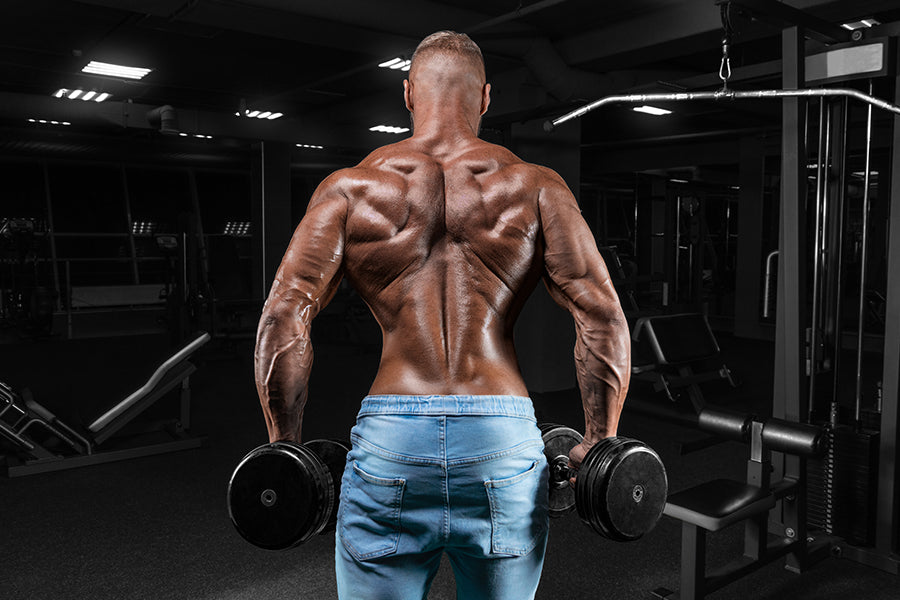Even if your biceps and triceps are bulging, having big arms means nothing if you don't have some bulging trap muscles to support your upper body arsenal.
Most men focus on their traps at the end of their shoulder workout, which is too late if you want a symmetrically sculpted upper torso. But to get traps that will bulge through your shirt, you need to do exercises that focus on the upper, middle, and lower portions of these muscles individually.
Dumbbell shrugs are a great exercise choice to build up sturdy shoulders and a powerful upper trapezius.
You can do various back exercises, but one of the simplest and most efficient is the dumbbell shrug, which targets your trap muscles (the ones that stick out around your shoulders and neck). But how confident are you that you're performing it properly?
Read on to become an expert on shrug exercises.
What are Dumbbell Shrugs?
When performed, shrugs isolate the upper trapezius muscle to build strength and muscle mass. As their name implies, they are a fundamental exercise that entails raising one's shoulders to one's ears while holding a pair of dumbbells at one's sides.
Dumbbell shrugs are a standard in the weightlifting and bodybuilding world because they are isolation exercises that target the upper trapezius muscles. You can bulk up your back, neck, and shoulders by doing these.
Related Article: Compound Vs. Isolation Exercises
How to Perform Dumbbell Shrugs?

Dumbbell shrugs are a great upper-body strength-building exercise for anyone, from complete beginners to seasoned bodybuilders. Dumbbell shrugs should be performed with a weight that can be handled for two to three sets of eight to twelve reps.
You should pick a weight that allows you to maintain proper form throughout the workout.
- Gather some light weights and hold them at your sides. Keep your hands in front of your legs with the palms facing down. Maintain an upright stance with your feet about shoulder-width apart, and your knees slightly bent. Maintain a neutral head and neck position with your shoulders over your hips. Keep your arms at your sides and bend your elbows just a little bit. Keep your chin tucked like you were holding an egg under your chin the whole time.
- Make sure your feet are firmly planted on the ground. Spread your toes out and distribute your weight evenly across the soles of your feet.
- Put some tension on your shoulders, hips, and core muscles beforehand. Keep your ribs down, and your pelvis tucked in ever-so-slightly.
- Keeping your head and neck in a neutral position, slowly bring your shoulders up toward your ears while keeping your arms at shoulder level.
- Hold at the peak of the motion for a moment.
- Bring your shoulders back to their original position gradually.
- Perform as many times as you like.
Muscles Worked By the Shrug
Here are the muscles that are targeted by the shrug.
Upper and Mid Trapezius
The shrug primarily engages the upper traps, with the mid trap contributing in a supporting role. During heavy lifts like deadlifts and farmer's walks, the upper traps help elevate the shoulder and support the shoulder girdle against downward forces.
Levator Scapulae
The levator scapulae are responsible for shrugging the shoulders, which is another way of saying that they elevate the scapula. This muscle is worked specifically by shrugging your shoulders.
Upper Back and Shoulder Stabilizers
By helping to resist the forward and inward pull of the dumbbell as the movement is performed, muscles such as the rhomboids and the rotator cuff muscles can contribute to maintaining a strong shoulder position.
Forearms
Your grip gets stronger every time you grab a dumbbell and lift it. This includes the shrug as well. A hook grip or lifting straps should be used to effectively train the traps if grip becomes the limiting factor in shrugging performance.
Related Article: Blow Up Your Forearms Using a Forearm Twister
Benefits of the Shrug
The ability of the shrug to assist in the construction of large, robust traps is its primary advantage, but this is not all it presents. The primary advantages of the shrug are listed below.
Improved Upper Back Strength
Any serious lifter will tell you that a strong upper back is essential for deadlifts and back squats. You need a strong upper back to keep your spine in a neutral position while performing deadlifts. It provides a firmer foundation from which to perform the bench press. In addition, a barbell resting on your traps provides superior stability during squats.
Improved Olympic Lifting Ability
When performing the clean or the snatch, an explosive shrug helps ensure that the weights travel in a vertical path and enables the lifter to reach their full extension. Therefore, developing the shrug through direct training can boost Olympic lift performance.
Stronger, More Stable Neck Muscles
A strong neck is essential for players of contact sports such as American football, rugby, hockey, and combat sports. A strong and stable neck is essential for athletes in contact sports, and shrugs can be a part of a comprehensive program to build just that.
Improved Physique
Using shrugs is one of the most effective ways to increase the size of your traps. Large, powerful traps contribute to the appearance of a muscular frame, which many weightlifters strive to achieve.
Shrug Variations
Nothing beats shrugs as a supplementary exercise for stimulating growth in the upper traps. But by adding small changes to regular shrugs, you can build better upper trap strength, power, and endurance.
Let’s take a look:
Seated Dumbbell Shrug

The standard dumbbell shrug can make some gym-goers use too much hip movement. This is not something you should do. Dumbbell shrugs can be done while seated or kneeling, eliminating the legs as a potential source of injury.
- Grasp a pair of dumbbells and move to a seated position on a bench.
- Bring your shoulders toward your ears and squeeze your traps for two to three seconds.
- Repeat.
Snatch-Grip Shrugs

You can use a snatch (wide) grip when shrugging. This is a great way to strengthen the muscles used in the shrug from various perspectives. There are various ways to improve the ability to transfer to new tasks. For instance, a wide-grip or snatch-grip shrug will have a higher degree of transfer if you try to increase your pull in the snatch by using the shrug.
The ideal position depends on an individual’s needs, on factors like size and shape. Use the wider grip variation if it facilitates a stronger mind-muscle connection or a more robust pump.
- Stand up tall and grasp a barbell with a wide/snatch grip.
- While holding this wider grip, bring your shoulders toward your ears and squeeze your traps for two to three seconds.
- Repeat
Barbell Shrug

Don’t have a dumbbell yet, don’t worry; you can use a barbell ( even a kettlebell) instead.
- Maintain an upright stance with your feet hip-width apart and your arms at your sides, palms toward you.
- Shrug your shoulder and hold for a count of two.
- Bring yourself slowly back to the original position.
- Repeat
Face Pulls

When it comes to working out the upper body, face pulls are an exercise that is frequently neglected. On the other hand, they are excellent exercises for developing muscle, improving posture, and fostering good shoulder health.
- Attach a rope to a cable machine.
- Take hold of the rope with both hands, and then pull it toward your face.
- Throughout the movement, ensure that your upper arms are perpendicular to the ground and that your elbows are higher than your wrists.
- Bring the rope back to its starting position gradually.
FAQs
1. When should I do shrugs?
Consider incorporating them into your routine occasionally to gain additional size and strength in the traps. Compared to other major muscle groups, traps recover quickly and can be trained multiple times per week without causing problems for most weightlifters.
2. are traps hard to grow?
The trapezius is a muscle primarily used for endurance (if you think about it, it has to hold up the weight of your arms all day long and thus would respond better to a higher rep workout). In other words, it needs a lot of repetition to grow.
3. Should anyone avoid shrugs?
Many people are upper trap dominant due to prolonged sitting with poor posture, so there is a trend in the general fitness world to avoid shrugging. The loaded stretch component of the shrug, when incorporated into a holistic training regimen, may be beneficial for people with this postural pattern. No training course should exclude this exercise if it can be performed without discomfort.
Conclusion
The shrug is a worthwhile exercise, provided that it is performed correctly. They are surprisingly challenging, primarily when performed with heavy weights, and they significantly contribute to muscle growth in the upper back region (a hard-to-target area everyone wants).
You can eventually nail down this lift using proper form and technique, and you will be rewarded with great-looking upper trap muscle. Happy shrugging!











